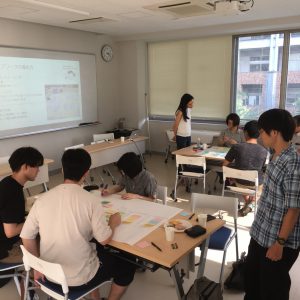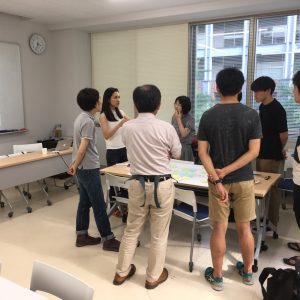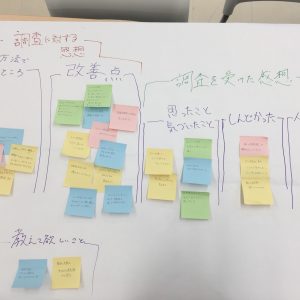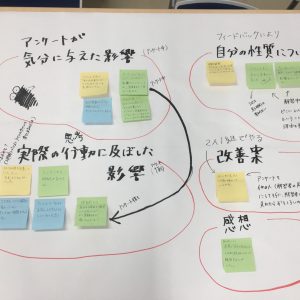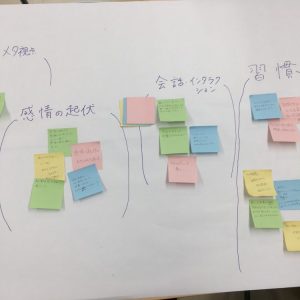
How emotional monitering affect on lifestyle
“Monitoring,” make the patient record their own states (e.g. mood, pain, sleep) every day, is one of the clinical methods used for the purpose of 1) the therapist to gain further information of the change of state in daily context to assess the patient and 2) let the patient to externalize their situation and understand it objectively. The usage of this method has increased due to the spread of information and communication technology (ICT) in clinical settings. And experimental sampling method (ESM), a method of data correction to record the responders’ state several times a day as well as monitoring in clinical settings, has been gaining more attention these days.
Although the emotional effect of affect monitoring has been discussed, it has been unknown how affect monitoring affect the life style of the responder. The aim of this workshop was to know further about the effect of affect monitoring in a broader point of view.
This workshop was announced as a feedback meeting of the participants of ESM study (monitoring their affect five times a day for two weeks) conducted by the projector. Entries discussed about “What they felt during the affect monitoring” and “How the affect monitoring effected their life” in the meeting.
From the discussion, we first had a lot of suggestions for the better procedure of affect monitoring in the future, such as to choose the media (e.g. e-mail, SNS) most convenient for each responder, to choose the time of the monitoring according to their living hours (e.g. 9 am – 6 pm, 3 pm – 0 am) and to add a column to the form to let the responder to free write their thoughts if they want.
At the second discussion, there were some suggestions that the affect monitoring was functioning as a reward system: “recording itself led to some kind of sense of accomplish;” “it felt good to have the feedback of the number of answers.” Others suggested the affect monitoring helped to sort their chaotic emotions. Additionally, there were some opinions about the behavioral effect of monitoring (such as reducing the time of watching SNSs) and the behavioral changes led to another emotional change (such as the decrease of time watching Twitter helped to reduce the chance of getting depressed by being exposed to others information).
The behavioral effect and the subsequent emotional effect of affect monitoring has not been discussed so far. Further investigation could contribute to the broader understanding of the results of applying affect monitoring. These knowledge will help the more effective use of monitoring in both clinical and research settings.
企画の背景
日常における感情の測定・記録は「モニタリング」として臨床場面で使用され,主に①支援者(臨床心理士など)が相談室の外でのクライエントの生活について情報を得ること,②クライエント本人が状態を把握し,状態が客体化されることが狙いとなる。
近年のICT普及に伴い,モニタリングは臨床現場でより利用しやすい手法となっている。加えて,研究の場面においても,モニタリング同様に参加者が自身の思考や感情・行動・環境について答える方法(経験サンプリング法)が注目されている。
感情をモニタリングすることが感情・気分に与える影響についてこれまで注目されてきた一方で,感情モニタリングが生活の中でどのように影響を与えるかについては検討されてきていない。そこで今回は,企画者の経験サンプリング研究に参加し,2週間に渡る感情モニタリングを体験した一般成人を対象として,感情モニタリングによる生活スタイルへの影響について議論した。
どんなワークショップ?
WSでは,同一の調査に参加された一般成人を対象とした。まず自己紹介として,調査に参加した経緯や普段どのような生活をしているかについて共有した。その中で,年齢や属性のばらつきがあるようにグループ分けを行なった。続いて,企画者からWSの背景や目的を共有した。参加者が体験した調査の内容について復習し,グループワークに移行した。前半は,「調査に参加して感じたことや良かった部分・改善していける部分」について議論を行い,後半は「感情モニタリングが生活にどのように影響を与えていたか」について話し合った。グループワークは,各テーマについての意見をポストイットに書き,模造紙の上でグルーピングを行うものであった。2グループ(3〜4人ずつ)でそれぞれワークを行い,その後結果を共有し合いながら共通点や相違点について話し合った。最後にWSについてまとめや振り返りを行い,解散とした。
プログラム
| 14:00 | 集合 | |
|---|---|---|
| 14:10 | 自己紹介,グループ分け | |
| 14:20 | WSの背景・目的の説明,調査内容の振り返り | |
| 14:40 | 参加した感想・改善点(グループワーク1) | |
| 15:10 | グループワーク1の結果共有 | |
| 15:30 | 〜〜休憩〜〜 | |
| 15:45 | 前半の振り返り | |
| 15:50 | 感情モニタリングが生活に与える影響(グループワーク2) | |
| 16:20 | グループワーク2の結果共有 | |
| 16:40 | WSのまとめ,振り返り | |
| 17:00 | 解散 |
ワークショップの成果
前半のグループワークからは,「気分の変動がないことに気づいた」などの感想が語られ,感情モニタリングの方法として今後より参加者にとって回答しやすいよう改善するためのヒントを得ることができた(fig.3-4)。「感情モニタリングが生活に与える影響」の結果として,「スマートフォンを触る時間は変わらなかったが,SNSに触れる時間が減った」「自分がどのような出来事に気分の影響を受けやすいことに気づくことができた」などの効果が語られた(fig. 5-6)。
ふり返り
調査参加者のフィードバックを得ることで,臨床・研究の双方でのモニタリングの利用について改めて考える機会となった。支援者側ではなく,支援を受ける側の立場から意見がもらえたことは新鮮だった。
今回のモニタリング手法の良い点として①中間時点で回答回数のアナウンスがあったこと,②最後に自分の気分の特徴をまとめて知れたことが挙がった一方で,改善できる点としては①人に合わせてどのような媒体(メール,SNS等)を使用するかを選択できるようにすること,②生活リズムに合わせてモニタリングする時間帯を選択できるようにすること(9-18時,15-24時等),③その時々であったことを自由記述でかける欄もあると良いことなどが挙げられた。これらは,臨床・研究の両方に今後活かされる知見となる。
後半の議論からは,感情モニタリングが気分に与えた影響,そこから生活への影響について示唆を得ることができた。「回答をすることで達成感を得られた」「回答回数のフィードバックがあって嬉しかった」のように回答することが報酬として機能していたこと,「自分の気分の変化についてメタ的に理解することができた」「それぞれの感情について個別で答えることでカオスになっていた気持ちが整理された」のように振り返り・整理の機能があったことから,感情モニタリングが気分・感情に対して直接的に影響する部分があったことが語られた。また,「SNSを使う時間が減った」「Twitterを見る時間が減ったことでネガティブな感情が起こるきっかけが減った」といった,行動的な変化やそれに伴う間接的な気分への影響も挙げられていた。感情モニタリングの行動への影響についてはこれまで焦点が当てられてきておらず,感情モニタリングの効果の一部として今後検討していくことができるだろう。
| アイテム | PC,プロジェクター,インターネット環境(全体) |
|
|---|---|---|
| 開催日時 | 2019年8月24日 |
|
| 場所 | 東京大学本郷キャンパス教育学部棟405A教室 |
|
| 参加者・人数 | 7名/学部生・大学院生・社会人を含む一般成人 |
|
| 講師/ファシリテーター | 中村杏奈(東大・総合教育科学専攻),臨床心理学コース博士学生1名 |
原稿執筆:中村杏奈


